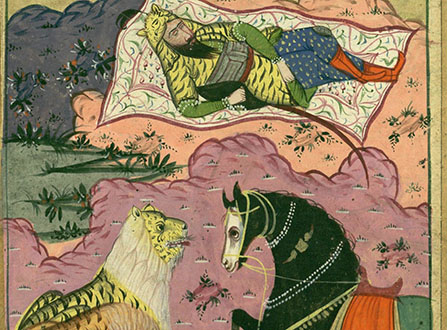Abu'l Qasem Firdausi and the Shahnamah
Abū al-Qāsim Firdawsī’s Shāh-nāma is an epochal work of Persian literature and an indispensable part of world literary heritage. Composed between 977 and 1010 CE, the Shāh-nāma, meaning Book of Kings, retells ancient Iranian myth and legend. Beginning with the creation of the world, the poem describe the exploits of heroes and the reigns of kings, the founding of the Zoroastrian religion, and concluding with the defeat of the Sasanian Empire (founded in 224) by conquering Muslim Arab armies and the death of the last Sasanian King Yazdgird III in 651. Written in elegant rhyming verse, at 50,000 couplets long the Shāh-nāma is one of the world’s longest epics, longer than the Iliad and the Odyssey combined.
Much of the Shāh-nāma’s mythological material, including the best-known stories of heroes and kings like Jamshīd, Kay Kāvus, Siyāvash, and Rustam, has roots in the very earliest strata of Iranian and specifically Zoroastrian culture. However, Firdawsī himself was a devout Muslim; the Shāh-nāma retells and reimagines the Iranian past not for religion’s sake but for cultural and specifically linguistic reasons. The poem was composed under the Samanid and Ghaznavid dynasties, both of which adopted Persian—which had been eclipsed by Arabic as the lingua franca—as the language of culture and court. The Shāh-nāma is the outstanding example of this shift, which exemplified a period known as the “Iranian intermezzo,” between the decline of the Arab Abbasid Empire in the early ninth century and the rise of the Seljuq Turks in the eleventh.
In reworking earlier sources, including prose chronologies of the pre-Islamic Iranian kings, Firdawsī had no less lofty a goal than reviving Iranian civilization. To a large extent—though of course not on his own—he succeeded. The Shāh-nāma was and remains the cornerstone of Persian culture and Iranian identity. Shāh-nāma verses are still recited as proverbial in the streets of twenty-first century Tehran. The hero Rustam’s unwitting murder of his son Suhrāb in battle, the machinations of the Turanian Afrāsiyāb, the mystical occultation of King Kay Khusraw, and other moving and tragic tales are still parsed, interpreted, and retold.
In a specifically literary vein, the Shāh-nāma has inspired numerous imitations and in Persian. Some later authors composed similar epic poems in rhyming couplets that detailed further exploits of principal (or minor characters), and others wrote “books of kings” devoted to flesh-and-blood rulers. In translation, Firdawsī’s work has become part of the canon of world literature.




